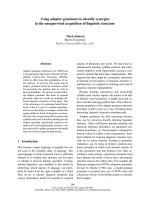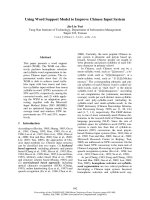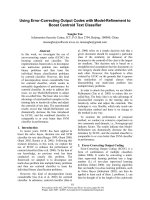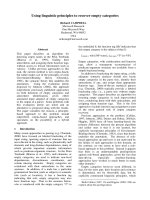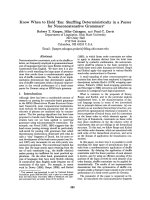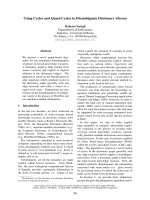Báo cáo khoa học: "Using Syntax to Disambiguate Explicit Discourse Connectives in Text" pot
Bạn đang xem bản rút gọn của tài liệu. Xem và tải ngay bản đầy đủ của tài liệu tại đây (95.84 KB, 4 trang )
Proceedings of the ACL-IJCNLP 2009 Conference Short Papers, pages 13–16,
Suntec, Singapore, 4 August 2009.
c
2009 ACL and AFNLP
Using Syntax to Disambiguate Explicit Discourse Connectives in Text
∗
Emily Pitler and Ani Nenkova
Computer and Information Science
University of Pennsylvania
Philadelphia, PA 19104, USA
epitler,
Abstract
Discourse connectives are words or
phrases such as once, since, and on
the contrary that explicitly signal the
presence of a discourse relation. There
are two types of ambiguity that need to
be resolved during discourse processing.
First, a word can be ambiguous between
discourse or non-discourse usage. For
example, once can be either a temporal
discourse connective or a simply a word
meaning “formerly”. Secondly, some
connectives are ambiguous in terms of the
relation they mark. For example since
can serve as either a temporal or causal
connective. We demonstrate that syntactic
features improve performance in both
disambiguation tasks. We report state-of-
the-art results for identifying discourse
vs. non-discourse usage and human-level
performance on sense disambiguation.
1 Introduction
Discourse connectives are often used to explicitly
mark the presence of a discourse relation between
two textual units. Some connectives are largely
unambiguous, such as although and additionally,
which are almost always used as discourse con-
nectives and the relations they signal are unam-
biguously identified as comparison and expansion,
respectively. However, not all words and phrases
that can serve as discourse connectives have these
desirable properties.
Some linguistic expressions are ambiguous be-
tween DISCOURSE AND NON-DISCOURSE US-
AGE. Consider for example the following sen-
tences containing and and once.
∗
This work was partially supported by NSF grants IIS-
0803159, IIS-0705671 and IGERT 0504487.
(1a) Selling picked up as previous buyers bailed out of their
positions and aggressive short sellers– anticipating fur-
ther declines–moved in.
(1b) My favorite colors are blue and green.
(2a) The asbestos fiber, crocidolite, is unusually resilient
once it enters the lungs, with even brief exposures to
it causing symptoms that show up decades later, re-
searchers said.
(2b) A form of asbestos once used to make Kent cigarette
filters has caused a high percentage of cancer deaths
among a group of workers exposed to it more than 30
years ago, researchers reported.
In sentence (1a), and is a discourse connec-
tive between the two clauses linked by an elabo-
ration/expansion relation; in sentence (1b), the oc-
currence of and is non-discourse. Similarly in sen-
tence (2a), once is a discourse connective marking
the temporal relation between the clauses “The as-
bestos fiber, crocidolite is unusually resilient” and
“it enters the lungs”. In contrast, in sentence (2b),
once occurs with a non-discourse sense, meaning
“formerly” and modifying “used”.
The only comprehensive study of discourse vs.
non-discourse usage in written text
1
was done in
the context of developing a complete discourse
parser for unrestricted text using surface features
(Marcu, 2000). Based on the findings from a
corpus study, Marcu’s parser “ignored both cue
phrases that had a sentential role in a majority of
the instances in the corpus and those that were
too ambiguous to be explored in the context of a
surface-based approach”.
The other ambiguity that arises during dis-
course processing involves DISCOURSE RELA-
TION SENSE. The discourse connective since for
1
The discourse vs. non-discourse usage ambiguity is even
more problematic in spoken dialogues because there the num-
ber of potential discourse markers is greater than that in writ-
ten text, including common words such as now, well and
okay. Prosodic and acoustic features are the most powerful
indicators of discourse vs. non-discourse usage in that genre
(Hirschberg and Litman, 1993; Gravano et al., 2007)
13
instance can signal either a temporal or a causal
relation as shown in the following examples from
Miltsakaki et al. (2005):
(3a) There have been more than 100 mergers and acquisi-
tions within the European paper industry since the most
recent wave of friendly takeovers was completed in the
U.S. in 1986.
(3b) It was a far safer deal for lenders since NWA had a
healthier cash flow and more collateral on hand.
Most prior work on relation sense identifica-
tion reports results obtained on data consisting of
both explicit and implicit relations (Wellner et al.,
2006; Soricut and Marcu, 2003). Implicit relations
are those inferred by the reader in the absence of
a discourse connective and so are hard to identify
automatically. Explicit relations are much easier
(Pitler et al., 2008).
In this paper, we explore the predictive power of
syntactic features for both the discourse vs. non-
discourse usage (Section 3) and discourse relation
sense (Section 4) prediction tasks for explicit con-
nectives in written text. For both tasks we report
high classification accuracies close to 95%.
2 Corpus and features
2.1 Penn Discourse Treebank
In our work we use the Penn Discourse Treebank
(PDTB) (Prasad et al., 2008), the largest public
resource containing discourse annotations. The
corpus contains annotations of 18,459 instances
of 100 explicit discourse connectives. Each dis-
course connective is assigned a sense from a three-
level hierarchy of senses. In our experiments
we consider only the top level categories: Ex-
pansion (one clause is elaborating information in
the other), Comparison (information in the two
clauses is compared or contrasted), Contingency
(one clause expresses the cause of the other), and
Temporal (information in two clauses are related
because of their timing). These top-level discourse
relation senses are general enough to be annotated
with high inter-annotator agreement and are com-
mon to most theories of discourse.
2.2 Syntactic features
Syntactic features have been extensively used
for tasks such as argument identification: di-
viding sentences into elementary discourse units
among which discourse relations hold (Soricut
and Marcu, 2003; Wellner and Pustejovsky, 2007;
Fisher and Roark, 2007; Elwell and Baldridge,
2008). Syntax has not been used for discourse vs.
non-discourse disambiguation, but it is clear from
the examples above that discourse connectives ap-
pear in specific syntactic contexts.
The syntactic features we used were extracted
from the gold standard Penn Treebank (Marcus et
al., 1994) parses of the PDTB articles:
Self Category The highest node in the tree
which dominates the words in the connective but
nothing else. For single word connectives, this
might correspond to the POS tag of the word, how-
ever for multi-word connectives it will not. For
example, the cue phrase in addition is parsed as
(PP (IN In) (NP (NN addition) )). While the POS
tags of “in” and “addition” are preposition and
noun, respectively, together the Self Category of
the phrase is prepositional phrase.
Parent Category The category of the immedi-
ate parent of the Self Category. This feature is
especially helpful for disambiguating cases simi-
lar to example (1b) above in which the parent of
and would be an NP (the noun phrase “blue and
green”), which will rarely be the case when and
has a discourse function.
Left Sibling Category The syntactic category
of the sibling immediately to the left of the Self
Category. If the left sibling does not exist, this fea-
tures takes the value “NONE”. Note that having no
left sibling implies that the connective is the first
substring inside its Parent Category. In example
(1a), this feature would be “NONE”, while in ex-
ample (1b), the left sibling of and is “NP”.
Right Sibling Category The syntactic category
of the sibling immediately to the right of the Self
Category. English is a right-branching language,
and so dependents tend to occur after their heads.
Thus, the right sibling is particularly important as
it is often the dependent of the potential discourse
connective under investigation. If the connective
string has a discourse function, then this depen-
dent will often be a clause (SBAR). For example,
the discourse usage in “After I went to the store,
I went home” can be distinguished from the non-
discourse usage in “After May, I will go on vaca-
tion” based on the categories of their right siblings.
Just knowing the syntactic category of the right
sibling is sometimes not enough; experiments on
the development set showed improvements by in-
cluding more features about the right sibling.
Consider the example below:
(4) NASA won’t attempt a rescue; instead, it will try to pre-
dict whether any of the rubble will smash to the ground
14
and where.
The syntactic category of “where” is SBAR, so the
set of features above could not distinguish the sin-
gle word “where” from a full embedded clause
like “I went to the store”. In order to address
this deficiency, we include two additional features
about the contents of the right sibling, Right Sib-
ling Contains a VP and Right Sibling Contains
a Trace.
3 Discourse vs. non-discourse usage
Of the 100 connectives annotated in the PDTB,
only 11 appear as a discourse connective more
than 90% of the time: although, in turn, af-
terward, consequently, additionally, alternatively,
whereas, on the contrary, if and when, lest, and on
the one hand on the other hand. There is quite
a range among the most frequent connectives: al-
though appears as a discourse connective 91.4% of
the time, while or only serves a discourse function
2.8% of the times it appears.
For training and testing, we used explicit dis-
course connectives annotated in the PDTB as pos-
itive examples and occurrences of the same strings
in the PDTB texts that were not annotated as ex-
plicit connectives as negative examples.
Sections 0 and 1 of the PDTB were used for de-
velopment of the features described in the previous
section. Here we report results using a maximum
entropy classifier
2
using ten-fold cross-validation
over sections 2-22.
The results are shown in Table 3. Using the
string of the connective as the only feature sets
a reasonably high baseline, with an f-score of
75.33% and an accuracy of 85.86%. Interest-
ingly, using only the syntactic features, ignoring
the identity of the connective, is even better, re-
sulting in an f-score of 88.19% and accuracy of
92.25%. Using both the connective and syntactic
features is better than either individually, with an
f-score of 92.28% and accuracy of 95.04%.
We also experimented with combinations of
features. It is possible that different con-
nectives have different syntactic contexts for
discourse usage. Including pair-wise interac-
tion features between the connective and each
syntactic feature (features like connective=also-
RightSibling=SBAR) raised the f-score about
1.5%, to 93.63%. Adding interaction terms be-
tween pairs of syntactic features raises the f-score
2
Features Accuracy f-score
(1) Connective Only 85.86 75.33
(2) Syntax Only 92.25 88.19
(3) Connective+Syntax 95.04 92.28
(3)+Conn-Syn Interaction 95.99 93.63
(3)+Conn-Syn+Syn-Syn Interaction 96.26 94.19
Table 1: Discourse versus Non-discourse Usage
slightly more, to 94.19%. These results amount
to a 10% absolute improvement over those ob-
tained by Marcu (2000) in his corpus-based ap-
proach which achieves an f-score of 84.9%
3
for
identifying discourse connectives in text. While
bearing in mind that the evaluations were done on
different corpora and so are not directly compara-
ble, as well as that our results would likely drop
slightly if an automatic parser was used instead of
the gold-standard parses, syntactic features prove
highly beneficial for discourse vs. non-discourse
usage prediction, as expected.
4 Sense classification
While most connectives almost always occur with
just one of the senses (for example, because is al-
most always a Contingency), a few are quite am-
biguous. For example since is often a Temporal
relation, but also often indicates Contingency.
After developing syntactic features for the dis-
course versus non-discourse usage task, we inves-
tigated whether these same features would be use-
ful for sense disambiguation.
Experiments and results We do classification be-
tween the four senses for each explicit relation
and report results on ten-fold cross-validation over
sections 2-22 of the PDTB using a Naive Bayes
classifier
4
.
Annotators were allowed to provide two senses
for a given connective; in these cases, we consider
either sense to be correct
5
. Contingency and Tem-
poral are the senses most often annotated together.
The connectives most often doubly annotated in
the PDTB are when (205/989), and (183/2999),
and as (180/743).
Results are shown in Table 4. The sense clas-
sification accuracy using just the connective is al-
ready quite high, 93.67%. Incorporating the syn-
tactic features raises performance to 94.15% accu-
3
From the reported precision of 89.5% and recall of
80.8%
4
We also ran a MaxEnt classifier and achieved quite sim-
ilar but slightly lower results.
5
Counting only the first sense as correct leads to about 1%
lower accuracy.
15
Features Accuracy
Connective Only 93.67
Connective+Syntax+Conn-Syn 94.15
Interannotator agreement 94
on sense class (Prasad et al., 2008)
Table 2: Four-way sense classification of explicits
racy. While the improvement is not huge, note that
we seem to be approaching a performance ceiling.
The human inter-annotator agreement on the top
level sense class was also 94%, suggesting further
improvements may not be possible. We provide
some examples to give a sense of the type of er-
rors that still occur.
Error Analysis While Temporal relations are the
least frequent of the four senses, making up only
19% of the explicit relations, more than half of
the errors involve the Temporal class. By far
the most commonly confused pairing was Contin-
gency relations being classified as Temporal rela-
tions, making up 29% of our errors.
A random example of each of the most common
types of errors is given below.
(5) Builders get away with using sand and financiers junk
[when] society decides it’s okay, necessary even, to
look the other way. Predicted: Temporal Correct:
Contingency
(6) You get a rain at the wrong time [and] the crop is ruined.
Predicted: Expansion Correct: Contingency
(7) In the nine months, imports rose 20% to 155.039 trillion
lire [and] exports grew 18% to 140.106 trillion lire.
Predicted: Expansion Correct: Comparison
(8) [The biotechnology concern said] Spanish authorities
must still clear the price for the treatment [but] that
it expects to receive such approval by year end. Pre-
dicted: Comparison Correct: Expansion
Examples (6) and (7) show the relatively rare
scenario when and does not signal expansion, and
Example (8) shows but indicating a sense besides
comparison. In these cases where the connective
itself is not helpful in classifying the sense of the
relation, it may be useful to incorporate features
that were developed for classifying implicit rela-
tions (Sporleder and Lascarides, 2008).
5 Conclusion
We have shown that using a few syntactic features
leads to state-of-the-art accuracy for discourse vs.
non-discourse usage classification. Including syn-
tactic features also helps sense class identification,
and we have already attained results at the level of
human annotator agreement. These results taken
together show that explicit discourse connectives
can be identified automatically with high accuracy.
References
R. Elwell and J. Baldridge. 2008. Discourse connec-
tive argument identification with connective specific
rankers. In Proceedings of the International Confer-
ence on Semantic Computing, Santa Clara, CA.
S. Fisher and B. Roark. 2007. The utility of parse-
derived features for automatic discourse segmenta-
tion. In Proceedings of ACL, pages 488–495.
A. Gravano, S. Benus, H. Chavez, J. Hirschberg, and
L. Wilcox. 2007. On the role of context and prosody
in the interpretation of ’okay’. In Proceedings of
ACL, pages 800–807.
J. Hirschberg and D. Litman. 1993. Empirical stud-
ies on the disambiguation of cue phrases. Computa-
tional linguistics, 19(3):501–530.
D. Marcu. 2000. The rhetorical parsing of unrestricted
texts: A surface-based approach. Computational
Linguistics, 26(3):395–448.
M.P. Marcus, B. Santorini, and M.A. Marcinkiewicz.
1994. Building a large annotated corpus of en-
glish: The penn treebank. Computational Linguis-
tics, 19(2):313–330.
E. Miltsakaki, N. Dinesh, R. Prasad, A. Joshi, and
B. Webber. 2005. Experiments on sense annota-
tion and sense disambiguation of discourse connec-
tives. In Proceedings of the Fourth Workshop on
Treebanks and Linguistic Theories (TLT 2005).
E. Pitler, M. Raghupathy, H. Mehta, A. Nenkova,
A. Lee, and A. Joshi. 2008. Easily identifiable dis-
course relations. In COLING, short paper.
R. Prasad, N. Dinesh, A. Lee, E. Miltsakaki,
L. Robaldo, A. Joshi, and B. Webber. 2008. The
penn discourse treebank 2.0. In Proceedings of
LREC’08.
R. Soricut and D. Marcu. 2003. Sentence level dis-
course parsing using syntactic and lexical informa-
tion. In HLT-NAACL.
C. Sporleder and A. Lascarides. 2008. Using automat-
ically labelled examples to classify rhetorical rela-
tions: An assessment. Natural Language Engineer-
ing, 14:369–416.
B. Wellner and J. Pustejovsky. 2007. Automatically
identifying the arguments of discourse connectives.
In Proceedings of EMNLP-CoNLL, pages 92–101.
B. Wellner, J. Pustejovsky, C. Havasi, A. Rumshisky,
and R. Sauri. 2006. Classification of discourse co-
herence relations: An exploratory study using mul-
tiple knowledge sources. In Proceedings of the 7th
SIGdial Workshop on Discourse and Dialogue.
16


